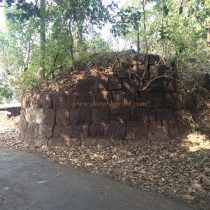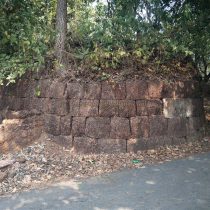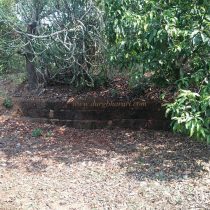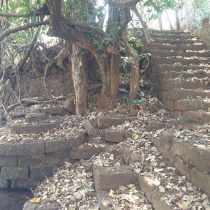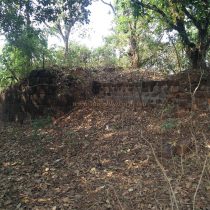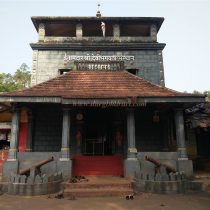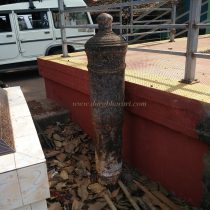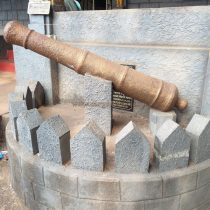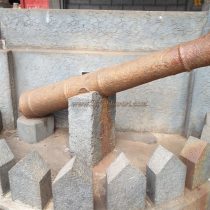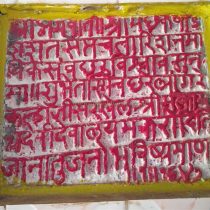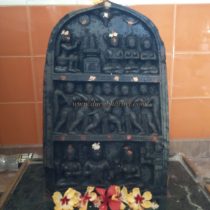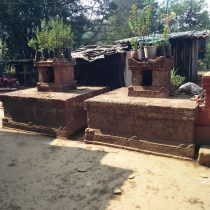KOTKAMTE
TYPE : GROUND FORT
DISTRICT : SINDHUDURG
HEIGHT : 0
GRADE : EASY
Most of the ground forts in Konkan are destroyed in the course of time and some of the forts are still standing, but they have been forgotten. Today, the existence of such forts remains only in the pages of history. Kotkamte is one such forgotten fort. This fort in Devgad taluka still carries the remains of the fort on its shoulders, but people think that only one bastion of this fort remains and it can be seen on the side of the road outside the village, and due to this reason they do not visit the fort. It is also said that the Bhagwati temple of Kotkamata is located in this fort. But in reality, the distance between Kotkamte fort and Bhagwati temple is half a km. The village of Kamate is named Kotkamte because of this fort. Kotkamte fort in Devgad taluka is 20 km from Devgad city and at a distance of 30 km on Nandgaon fork on Mumbai-Goa highway.
...
Before entering the village by both these routes, the bastion of this fort can be seen half a km away from the village. In many places, it is read that this is the only remaining bastion of the fort, but in reality, the situation is different. Situated on the banks of the river Naringre, this square-shaped fort is spread over an area of about one and a half-acre. The ramparts of the fort do not have one or two but five bastions and a rampart that is gradually getting burrowed under the ground. The hummock of the fort remains and it is not easy to reach the fort from anywhere except the gate. At the back of the fort is the Naringre river basin and adjacent to the ramparts of the fort there are steps and a bastion to descend into the river basin. The bastion and the steps are still standing. There are moats on all four sides of the fort although today these moats are extinguished with soil. The ground side of this moat is built of wrought stone. Looking at the mounds of soil at the beginning of the road, it seems that there should be a fort gate at this place to enter the fort There is a mango orchard inside the fort and due to neglect of this orchard, a large number of thorny bushes have grown. That’s the reason why we cannot explore the fort. Looking at the mango orchard in the fort, there is a possibility of a well inside the fort. Half an hour is enough to see the entire fort from outside. To curb the constant attacks by the Sawant's, the Maratha navy chief Kanhoji Angre erected a fort called Kotkamte in the center of the Devgad and Salshi provinces. He must have built a temple of Goddess Bhagwati along with this fort. An inscription of that meaning can be seen on this temple. The text of this inscription: - " श्री भगवती ॥श्री॥मछक षोडश शत: सत्पचत्वारिंशत माधिक संबंछर विश्वात सुनामा ॥ सुभे तं स्थिच छरे आंगरे कान्होजी सरखेल श्रीमत्कामश देवा देवालय मकरोदिती जाना तु जनो भविष्य माण: ॥१॥ (Shak 1647)“ The first mention of this fort is in a letter written by Wadikar Khem Sawant to the Portuguese between October and November 2, 1719. In the letter, Sawant informed about the new fort built by Angre and demanded ten cannons, cannonballs, horses, and boats to fight against it. In a joint campaign of Nanasaheb Peshwa and the British against Tulaji Angre, the Peshwas won the fort between 1755-56. According to the Portuguese records of 1774, Kotkamte fort was in the center of the Vijaydurg area. When Colonel Imlak captured Devgad on 7th April 1818, Kotkamte fort surrendered without a fight. In the survey of the forts conducted in 1862, it is mentioned that there are four cannons in Kotkamte fort. Three of these cannons can be seen on the premises of Bhagwati temple. Two of these cannons are at the entrance of the temple and one cannon is buried upside down nearby.
© Suresh Nimbalkar

